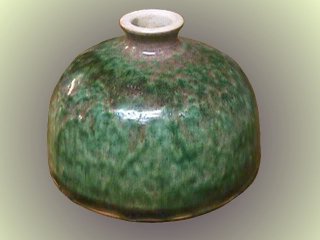Also known as a scholar's or writer's coupe, and sometimes
referred to as a brush-washer or brush-pot. These first appeared during the
Kangxi reign and seem to conform to a prescribed standard in both size
and shape. The colors vary, with the ox-blood and peachbloom being most common,
blue, celadon ware, and white a bit rarer, and recently a yellow glazed beehive
water-pot on display at the National Gallery of Art in Washington, D.C. has
gained some attention for it's rich yellow glaze. Those of Imperial quality
usually display three finely incised archaistic dragon medallions (or roundels)
just beneath the glaze.
The water-pot shown here presents some interesting
characteristics. First is the color, a deep green with spots of peachbloom
visible, mostly about the neck. It's my belief that this was meant to be
peachbloom, but conditions within the kiln produced otherwise. The mark is
of the Seal (or Temple) style, not the standard calligraphy mark usually
seen. It shows much wear around the inner neck with much of the glaze worn
away. The inside shoulder area was caked with mud and dirt residue which
leads me to believe that this was unearthed. The exterior shows some wear,
and there is fine glaze cracking overall. |

![]()